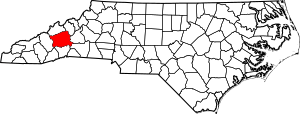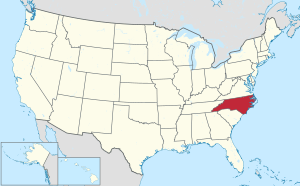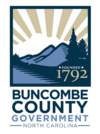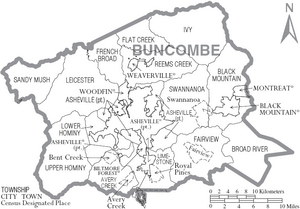Buncombe County, North Carolina facts for kids
Quick facts for kids
Buncombe County
|
|||||
|---|---|---|---|---|---|

Buncombe County Courthouse in Asheville
|
|||||
|
|||||
| Motto(s):
"People To Match Our Mountains"
|
|||||

Location within the U.S. state of North Carolina
|
|||||
 North Carolina's location within the U.S. |
|||||
| Country | |||||
| State | |||||
| Founded | 1792 | ||||
| Named for | Edward Buncombe | ||||
| Seat | Asheville | ||||
| Largest municipality | Asheville | ||||
| Area | |||||
| • Total | 659.95 sq mi (1,709.3 km2) | ||||
| • Land | 656.50 sq mi (1,700.3 km2) | ||||
| • Water | 3.45 sq mi (8.9 km2) 0.52% | ||||
| Population
(2020)
|
|||||
| • Total | 269,452 | ||||
| • Estimate
(2023)
|
275,901 | ||||
| • Density | 410.37/sq mi (158.44/km2) | ||||
| Time zone | UTC−5 (Eastern) | ||||
| • Summer (DST) | UTC−4 (EDT) | ||||
| Congressional district | 11th | ||||
Buncombe County (/ˈbʌŋkəm/ BUNK-um) is a county located in the U.S. state of North Carolina. It is classified within Western North Carolina. The 2020 census reported the population was 269,452, making it the 7th-most populous county in North Carolina. Its county seat is Asheville. Buncombe County is part of the Asheville, NC Metropolitan Statistical Area.
Contents
History
The area of modern day Buncombe County and its environs was originally populated by the Anigiduwagi, better known as the Cherokee people. Europeans, primarily of German, Scottish and English descent, began to live in Buncombe in the early 18th century. Some the earliest permanent European settlers in Buncombe arrived in 1784. These European settlers frequently broke their treaties with the Cherokee, gradually forcing them off of their land in Buncombe County by force.
In December 1792 and April 1793, John Dillard was a commissioner in a local political dispute of determining where the county seat of Buncombe County should be located. It was provided in an act creating Buncombe County for a committee of five persons to be appointed for the selection of the site. A dispute arose between two factions of Buncombe County residents on opposite sides of the Swannanoa River, one faction pressing for the county seat to be north of Swannanoa, which is now the center of Asheville, and the other faction demanding it to be at a place south of Swannanoa River, which later became known as the "Steam Saw Mill Place", and is now the southern part of the city of Asheville.
Buncombe County was organized by European Americans after the American Revolutionary War in the home of Colonel William Davidson, a cousin of William Lee Davidson who was elected as the county's first state senator. The first meeting of the county government took place in April 1792 in Colonel Davidson's barn (located on the present-day Biltmore Estate).
At first, deeds were recorded in Morganton, the nearest county seat. That was inconvenient for residents as roads were poor. In December 1792, seven men met to select a courthouse location for the county. The first courthouse was built at the present-day Pack Square site in Asheville.
The county was formed in 1791 from parts of Burke and Rutherford counties. It was named for Edward Buncombe, a colonel in the American Revolutionary War who was captured at the Battle of Germantown. An earlier proposed name was "Union County". The large county originally extended to the Tennessee line.
Many of the early settlers were Baptists. In 1807 the pastors of six churches, including the revivalist Sion Blythe, formed the French Broad Association of Baptist churches in the area.
As population increased in this part of the state, parts of the county were taken to organize new counties. In 1808 the western part of Buncombe County became Haywood County. In 1833 parts of Burke and Buncombe counties were combined to form Yancey County. In 1838 the southern part of what was left of Buncombe County became Henderson County. In 1851 parts of Buncombe and Yancey counties were combined to form Madison County. Finally, in 1925 the Broad River township of McDowell County was transferred to Buncombe County.
In 1820, a U.S. Congressman whose district included Buncombe County, unintentionally contributed a word to the English language. In the Sixteenth Congress, after lengthy debate on the Missouri Compromise, members of the House called for an immediate vote on that important question. Felix Walker rose to address his colleagues, insisting that his constituents expected him to make a speech "for Buncombe." It was later remarked that Walker's untimely and irrelevant oration was not just for Buncombe—it "was Buncombe." Buncombe, afterwards spelled bunkum and later shortened to bunk, became a term for empty, nonsensical talk. That, in turn, is the etymology of the verb debunk.
Geography
According to the U.S. Census Bureau, Buncombe county has a total area of 659.95 square miles (1,709.3 km2), of which 656.50 square miles (1,700.3 km2) is land and 3.45 square miles (8.9 km2) (0.52%) is water.
The French Broad River enters the county at its border with Henderson County to the south and flows north into Madison County. The source of the Swannanoa River, which joins the French Broad River in Asheville, is in northeast Buncombe County near Mount Mitchell, a part of the Black Mountains range. Mt. Mitchell is the highest point in the eastern United States at 6,684 ft. Its summit lies in adjacent Yancey County; the highest point in Buncombe County is Potato Knob, at 6400+ feet, which lies a short distance south of Mount Mitchell.
A milestone was achieved in 2003 when Interstate 26, still called Future I-26 in northern Buncombe County, was extended from Mars Hill (north of Asheville) to Johnson City, Tennessee. This completed a 20-year, half-billion dollar construction project through the Blue Ridge Mountains.
National protected areas
- Blue Ridge Parkway (part)
- Craggy Gardens
- Pisgah National Forest (part)
- Mount Pisgah (part)
- Nantahala National Forest (part)
State and local protected areas/sites
- Asheville Watershed
- Beaver Lake Bird Sanctuary
- Big Ivy Historical Park
- Biltmore Estate
- Chimney Rock State Park (part)
- Collier Cove Nature Preserve
- The North Carolina Arboretum
- Pisgah National Forest Game Land (part)
- Pisgah View State Park (part)
- Sandy Mush Game Land (part)
- Thomas Wolfe House
- Vance Birthplace
- Western North Carolina Nature Center
- Young Forest
Major water bodies
- Beaver Lake
- Beaverdam Creek
- Bent Creek
- Broad River
- Burnett Reservoir
- Cane Creek
- Flat Creek
- French Broad River
- Lake Julian
- Lake Kenilworth
- Lake Craig
- Lake Powhatan
- Lake Louise
- Left Fork Swannanoa River
- Little Pole Creek
- Long Valley Lake
- Newfound Creek
- North Fork Reservoir
- North Fork Swannanoa River
- Pole Creek
- Reems Creek
- Right Fork Swannanoa River
- Swannanoa River
- Tom Creek
- Turkey Creek
Adjacent counties
- Madison County – north
- Yancey County – northeast
- McDowell County – east
- Rutherford County – southeast
- Henderson County – south
- Transylvania County – southwest
- Haywood County – west
Major highways
Major infrastructure
- Asheville Regional Airport
Demographics
| Historical population | |||
|---|---|---|---|
| Census | Pop. | %± | |
| 1800 | 5,812 | — | |
| 1810 | 9,277 | 59.6% | |
| 1820 | 10,542 | 13.6% | |
| 1830 | 16,281 | 54.4% | |
| 1840 | 10,084 | −38.1% | |
| 1850 | 13,425 | 33.1% | |
| 1860 | 12,654 | −5.7% | |
| 1870 | 15,412 | 21.8% | |
| 1880 | 21,909 | 42.2% | |
| 1890 | 35,266 | 61.0% | |
| 1900 | 44,288 | 25.6% | |
| 1910 | 49,798 | 12.4% | |
| 1920 | 64,148 | 28.8% | |
| 1930 | 97,937 | 52.7% | |
| 1940 | 108,755 | 11.0% | |
| 1950 | 124,403 | 14.4% | |
| 1960 | 130,074 | 4.6% | |
| 1970 | 145,056 | 11.5% | |
| 1980 | 160,934 | 10.9% | |
| 1990 | 174,821 | 8.6% | |
| 2000 | 206,330 | 18.0% | |
| 2010 | 238,318 | 15.5% | |
| 2020 | 269,452 | 13.1% | |
| 2023 (est.) | 275,901 | 15.8% | |
| U.S. Decennial Census 1790–1960 1900–1990 1990–2000 2010 2020 |
|||
Since 1970, the county has had a steady rise in population, attracting retirees, second-home buyers and others from outside the region.
2020 census
| Race | Number | Percentage |
|---|---|---|
| White (non-Hispanic) | 214,862 | 79.74% |
| Black or African American (non-Hispanic) | 15,017 | 5.57% |
| Native American | 727 | 0.27% |
| Asian | 3,274 | 1.22% |
| Pacific Islander | 467 | 0.17% |
| Other/Mixed | 13,183 | 4.89% |
| Hispanic or Latino | 21,922 | 8.14% |
As of the 2020 census, there were 269,452 people, 106,741 households, and 63,675 families residing in the county. From 2010 to 2020, Buncombe County added 31,104 people or 13.0% population growth, making it the fastest growing county in Western North Carolina during the decade.
Economy
The North Carolina Department of Commerce reported that in September 2024 Buncombe County had the lowest unemployment rate of all of North Carolina's counties at a rate of 2.5 percent. In the aftermath of Hurricane Helene's impacts on the region, in October the department reported that Buncombe had the highest rate of unemployment in the state at 8.8 percent.
Communities
City
- Asheville (county seat and largest municipality)
Towns
Townships
Census-designated places
Unincorporated communities
- Alexander
- Arden
- Beaverdam
- Candler
- Coburn
- Enka
- Flat Creek
- Forks of Ivy
- Jupiter
- Leicester
- Oak Park
- Ridgecrest
- Sandymush
- Skyland
- Stocksville
- Wilson
See also
 In Spanish: Condado de Buncombe para niños
In Spanish: Condado de Buncombe para niños





